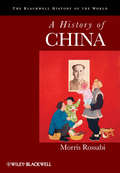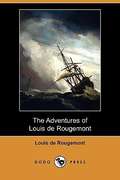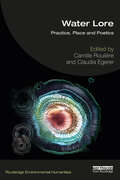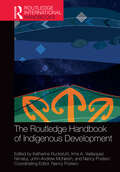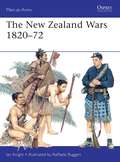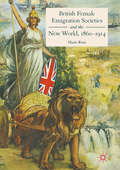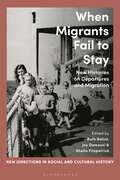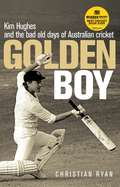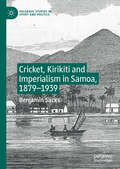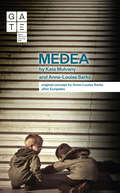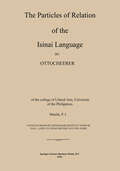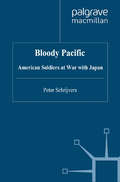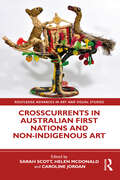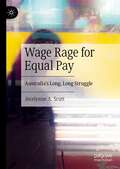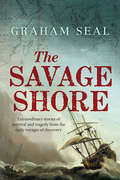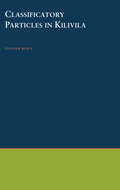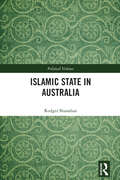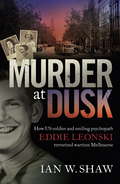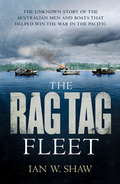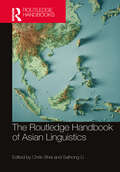- Table View
- List View
A History of China (Blackwell History of the World)
by Morris RossabiCapturing China’s past in all its complexity, this multi-faceted history portrays China in the context of a larger global world, while incorporating the narratives of Chinese as well as non-Chinese ethnic groups and discussing people traditionally left out of the story—peasants, women, merchants, and artisans. Offers a complete political, economic, social, and cultural history of China, covering the major events and trends Written in a clear and uncomplicated style by a distinguished historian with over four decades of experience teaching undergraduates Examines Chinese history through the lens of global history to better understand how foreign influences affected domestic policies and practices Depicts the role of non-Chinese ethnic groups in China, such as Tibetans and Uyghurs, and analyzes the Mongol and Manchu rulers and their impact on Chinese society Incorporates the narratives of people traditionally left out of Chinese history, including women, peasants, merchants, and artisans
A History of China (Blackwell History of the World)
by Morris RossabiCapturing China’s past in all its complexity, this multi-faceted history portrays China in the context of a larger global world, while incorporating the narratives of Chinese as well as non-Chinese ethnic groups and discussing people traditionally left out of the story—peasants, women, merchants, and artisans. Offers a complete political, economic, social, and cultural history of China, covering the major events and trends Written in a clear and uncomplicated style by a distinguished historian with over four decades of experience teaching undergraduates Examines Chinese history through the lens of global history to better understand how foreign influences affected domestic policies and practices Depicts the role of non-Chinese ethnic groups in China, such as Tibetans and Uyghurs, and analyzes the Mongol and Manchu rulers and their impact on Chinese society Incorporates the narratives of people traditionally left out of Chinese history, including women, peasants, merchants, and artisans
The Adventures of Louis de Rougemont
by Louis De RougemontLouis de Rougemont (1847-1921) was a would-be explorer who claimed to have had adventures in Australasia. "de Rougemont" was born Henri Louis Grin in 1847 in Suchy, Switzerland. <P> <P> In 1898 he began to write about his invented adventures in the British periodical The Wide World Magazine under the name Louis de Rougemont. He described his alleged exploits in search of pearls and gold in New Guinea and claimed to have spent thirty years living with Indigenous Australians in the Australian outback. He claimed that the tribe with whom he had lived had worshipped him as a god. He also claimed to have encountered the Gibson expedition of 1874. Various readers expressed disbelief in his tales from the start, for example, claiming that no one can actually ride a turtle. He had also claimed to have seen flying wombats. The fact that he could not place his travels on the map aroused suspicion. Readers' arguments in the pages of London newspaper, the Daily Chronicle, continued for months.
Water Lore: Practice, Place and Poetics (Routledge Environmental Humanities)
by Camille Roulière Claudia EgererLocated within the field of environmental humanities, this volume engages with one of the most pressing contemporary environmental challenges of our time: how can we shift our understanding and realign what water means to us? Water is increasingly at the centre of scientific and public debates about climate change. In these debates, rising sea levels compete against desertification; hurricanes and floods follow periods of prolonged drought. As we continue to pollute, canalise and desalinate waters, the ambiguous nature of our relationship with these entities becomes visible. From the paradisiac and pristine scenery of holiday postcards through to the devastated landscapes of post-tsunami news reports, images of waters surround us. And while we continue to damage what most sustains us, collective precarity grows. Breaking down disciplinary boundaries, with contributions from scholars in the visual arts, history, earth systems, anthropology, architecture, literature and creative writing, archaeology and music, this edited collection creates space for less-prominent perspectives, with many authors coming from female, Indigenous and LGBTQIA+ contexts. Combining established and emerging voices, and practice-led research and critical scholarship, the book explores water across its scientific, symbolic, material, imaginary, practical and aesthetic dimensions. It examines and interrogates our cultural construction and representation of water and, through original research and theory, suggests ways in which we can reframe the dialogue to create a better relationship with water sources in diverse contexts and geographies. This expansive book brings together key emerging scholarship on water persona and agency and would be an ideal supplementary text for discussions on the blue humanities, climate change, environmental anthropology and environmental history.
Water Lore: Practice, Place and Poetics (Routledge Environmental Humanities)
by Camille Roulière Claudia EgererLocated within the field of environmental humanities, this volume engages with one of the most pressing contemporary environmental challenges of our time: how can we shift our understanding and realign what water means to us? Water is increasingly at the centre of scientific and public debates about climate change. In these debates, rising sea levels compete against desertification; hurricanes and floods follow periods of prolonged drought. As we continue to pollute, canalise and desalinate waters, the ambiguous nature of our relationship with these entities becomes visible. From the paradisiac and pristine scenery of holiday postcards through to the devastated landscapes of post-tsunami news reports, images of waters surround us. And while we continue to damage what most sustains us, collective precarity grows. Breaking down disciplinary boundaries, with contributions from scholars in the visual arts, history, earth systems, anthropology, architecture, literature and creative writing, archaeology and music, this edited collection creates space for less-prominent perspectives, with many authors coming from female, Indigenous and LGBTQIA+ contexts. Combining established and emerging voices, and practice-led research and critical scholarship, the book explores water across its scientific, symbolic, material, imaginary, practical and aesthetic dimensions. It examines and interrogates our cultural construction and representation of water and, through original research and theory, suggests ways in which we can reframe the dialogue to create a better relationship with water sources in diverse contexts and geographies. This expansive book brings together key emerging scholarship on water persona and agency and would be an ideal supplementary text for discussions on the blue humanities, climate change, environmental anthropology and environmental history.
The Routledge Handbook of Indigenous Development (Routledge International Handbooks)
by Katharina Ruckstuhl Irma A. Velásquez Nimatuj John-Andrew McNeish Nancy PosteroThis Handbook inverts the lens on development, asking what Indigenous communities across the globe hope and build for themselves. In contrast to earlier writing on development, this volume focuses on Indigenous peoples as inspiring theorists and potent political actors who resist the ongoing destruction of their livelihoods. To foster their own visions of development, they look from the present back to Indigenous pasts and forward to Indigenous futures. Key questions: How do Indigenous theories of justice, sovereignty, and relations between humans and non-humans inform their understandings of development? How have Indigenous people used Rights of Nature, legal pluralism, and global governance systems to push for their visions? How do Indigenous relations with the Earth inform their struggles against natural resource extraction? How have native peoples negotiated the dangers and benefits of capitalism to foster their own life projects? How do Indigenous peoples in diaspora and in cities around the world contribute to Indigenous futures? How can Indigenous intellectuals, artists, and scientists control their intellectual property and knowledge systems and bring into being meaningful collective life projects? The book is intended for Indigenous and non-Indigenous activists, communities, scholars, and students. It provides a guide to current thinking across the disciplines that converge in the study of development, including geography, anthropology, environmental studies, development studies, political science, and Indigenous studies.
The Routledge Handbook of Indigenous Development (Routledge International Handbooks)
by Katharina Ruckstuhl Irma A. Velásquez Nimatuj John-Andrew McNeish Nancy PosteroThis Handbook inverts the lens on development, asking what Indigenous communities across the globe hope and build for themselves. In contrast to earlier writing on development, this volume focuses on Indigenous peoples as inspiring theorists and potent political actors who resist the ongoing destruction of their livelihoods. To foster their own visions of development, they look from the present back to Indigenous pasts and forward to Indigenous futures. Key questions: How do Indigenous theories of justice, sovereignty, and relations between humans and non-humans inform their understandings of development? How have Indigenous people used Rights of Nature, legal pluralism, and global governance systems to push for their visions? How do Indigenous relations with the Earth inform their struggles against natural resource extraction? How have native peoples negotiated the dangers and benefits of capitalism to foster their own life projects? How do Indigenous peoples in diaspora and in cities around the world contribute to Indigenous futures? How can Indigenous intellectuals, artists, and scientists control their intellectual property and knowledge systems and bring into being meaningful collective life projects? The book is intended for Indigenous and non-Indigenous activists, communities, scholars, and students. It provides a guide to current thinking across the disciplines that converge in the study of development, including geography, anthropology, environmental studies, development studies, political science, and Indigenous studies.
The New Zealand Wars 1820–72 (Men-at-Arms)
by Raffaele Ruggeri Ian KnightBetween 1845 and 1872, various groups of Maori were involved in a series of wars of resistance against British settlers. The Maori had a fierce and long-established warrior tradition and subduing them took a lengthy British Army commitment, only surpassed in the Victorian period by that on the North-West Frontier of India. Warfare had been endemic in pre-colonial New Zealand and Maori groups maintained fortified villages or pas. The small early British coastal settlements were tolerated, and in the 1820s a chief named Hongi Hika travelled to Britain with a missionary and returned laden with gifts. He promptly exchanged these for muskets, and began an aggressive 15-year expansion. By the 1860s many Maori had acquired firearms and had perfected their bush-warfare tactics. In the last phase of the wars a religious movement, Pai Maarire ('Hau Hau'), inspired remarkable guerrilla leaders such as Te Kooti Arikirangi to renewed resistance. This final phase saw a reduction in British Army forces. European victory was not total, but led to a negotiated peace that preserved some of the Maori people's territories and freedoms.
British Female Emigration Societies and the New World, 1860-1914
by Marie RuizThis book focuses on the departure of Britain’s 'surplus' women to Australia and New Zealand organised by Victorian British female emigration societies. Starting with an analysis of the surplus of women question, it then explores the philanthropic nature of the organisations (the Female Middle Class Emigration Society, the Women’s Emigration Society, the British Women’s Emigration Association, and the Church Emigration Society). The study of the strict selection of distressed gentlewomen emigrants is followed by an analysis of their marketing value, and an appraisal of women’s imperialism. Finally, this work shows that the female emigrants under study partook in the consolidation of the colonial middle-class.
British Female Emigration Societies and the New World, 1860-1914
by Marie RuizThis book focuses on the departure of Britain’s 'surplus' women to Australia and New Zealand organised by Victorian British female emigration societies. Starting with an analysis of the surplus of women question, it then explores the philanthropic nature of the organisations (the Female Middle Class Emigration Society, the Women’s Emigration Society, the British Women’s Emigration Association, and the Church Emigration Society). The study of the strict selection of distressed gentlewomen emigrants is followed by an analysis of their marketing value, and an appraisal of women’s imperialism. Finally, this work shows that the female emigrants under study partook in the consolidation of the colonial middle-class.
When Migrants Fail to Stay: New Histories on Departures and Migration (New Directions in Social and Cultural History)
by Ruth Balint, Joy Damousi, and Sheila FitzpatrickThe aftermath of the Second World War marked a radical new moment in the history of migration. For the millions of refugees stranded in Europe, China and Africa, it offered the possibility of mobility to the 'new world' of the West; for countries like Australia that accepted them, it marked the beginning of a radical reimagining of its identity as an immigrant nation. For the next few decades, Australia was transformed by waves of migrants and refugees. However, two of the five million who came between 1947 and 1985 later left. When Migrants Fail to Stay examines why this happened. This innovative collection of essays explores a distinctive form of departure, and its importance in shaping and defining the reordering of societies after World War II. Esteemed historians Ruth Balint, Joy Damousi, and Sheila Fitzpatrick lead a cast of emerging and established scholars to probe this overlooked phenomenon. In doing so, this book enhances our understanding of the migration and its history.
Golden Boy: Kim Hughes and the bad old days of Australian cricket
by Christian Ryan**Voted Wisden Cricket Monthly's best cricket book ever in 2019**WINNER, BEST CRICKET BOOK, BRITISH SPORTS BOOK AWARDS 2010_________________Golden Boy is a blistering exposé of the tumultuous Lillee/Marsh/Chappells era of Australian cricket, as viewed through the lens of flawed genius Kim Hughes._________________Kim Hughes was one of the most majestic and daring batsmen to play for Australia in the last 40 years. Golden curled and boyishly handsome, his rise and fall as captain and player is unparalleled in cricketing history. He played several innings that count as all-time classics, but it's his tearful resignation from the captaincy that is remembered.Insecure but arrogant, abrasive but charming; in Hughes' character were the seeds of his own destruction. Yet was Hughes' fall partly due to those around him, men who are themselves legends in Australia's cricketing history? Lillee, Marsh, the Chappells, all had their agendas, all were unhappy with his selection and performance as captain - evidenced by Dennis Lillee's tendency to aim bouncers relentlessly at Hughes' head during net practice.Hughes' arrival on the Test scene coincided with the most turbulent time Australian cricket has ever seen - first Kerry Packer's World Series Cricket, then the rebel tours to South Africa. Both had dramatic effects on Hughes' career. As he traces the high points and the low, Christian Ryan sheds new and fascinating light on the cricket - and the cricketers - of the times.
Cricket, Kirikiti and Imperialism in Samoa, 1879–1939 (Palgrave Studies in Sport and Politics)
by Benjamin SacksThis book considers how Samoans embraced and reshaped the English game of cricket, recasting it as a distinctively Samoan pastime, kirikiti. Starting with cricket’s introduction to the islands in 1879, it uses both cricket and kirikiti to trace six decades of contest between and within the categories of ‘colonisers’ and ‘colonised.’ How and why did Samoans adapt and appropriate the imperial game? How did officials, missionaries, colonists, soldiers and those with mixed foreign and Samoan heritage understand and respond to the real and symbolic challenges kirikiti presented? And how did Samoans use both games to navigate foreign colonialism(s)? By investigating these questions, Benjamin Sacks suggests alternative frameworks for conceptualising sporting transfer and adoption, and advances understandings of how power, politics and identity were manifested through sport, in Samoa and across the globe.
Medea: A Radical New Version from the Perspective of the Children
by Anne-Louise Sarks Kate MulvanyTwo boys are playing a game. They fight, they laugh, they jump up and down, they play dead. Downstairs, their parents – Medea and Jason – are arguing. As the shouting gets louder, their bedroom will no longer be able to protect them from the violence of the outside world. Their iconic fate, at the hands of their mother, will ensure that they enter mythology as two of the most tragic siblings of all time. Medea is presented in association with Belvoir, Sydney and directed by Anne-Louise Sarks whose original production of the play was highly critically acclaimed. The production turns Euripides’ classic tale on its head – presenting the tragedy from the children’s perspective.
Bloody Pacific: American Soldiers at War with Japan
by P. SchrijversBased on countless diaries and letters, Schrijvers recounts American GIs' experiences in Asia and the Pacific. From the daunting spaces of the China-India theatre to the fortress islands of Iwo Jima and Okinawa, he brings to life their struggle with suffocating wilderness, devastating diseases, and Japanese soldiers who preferred death over life.
Crosscurrents in Australian First Nations and Non-Indigenous Art (Routledge Advances in Art and Visual Studies)
by Sarah Scott Helen McDonald Caroline JordanThis edited collection examines art resulting from cross-cultural interactions between Australian First Nations and non-Indigenous people, from the British invasion to today. Focusing on themes of collaboration and dialogue, the book includes two conversations between First Nations and non-Indigenous authors and an historian’s self-reflexive account of mediating between traditional owners and an international art auction house to repatriate art. There are studies of ‘reverse appropriation‘ by early nineteenth-century Aboriginal carvers of tourist artefacts and the production of enigmatic toa. Cross-cultural dialogue is traced from the post-war period to ‘Aboriginalism’ in design and the First Nations fashion industry of today. Transculturation, conceptualism, and collaboration are contextualised in the 1980s, a pivotal decade for the growth of collaborative First Nations exhibitions. Within the current circumstances of political protest in photographic portraiture and against the mining of sacred Aboriginal land, Crosscurrents in Australian First Nations and Non-Indigenous Art testifies to the need for Australian institutions to collaborate with First Nations people more often and better. This book will appeal to students and scholars of art history, Indigenous anthropology, and museum and heritage studies.
Wage Rage for Equal Pay: Australia’s Long, Long Struggle
by Jocelynne A. ScuttThis book makes a major contribution to the continuing legal and historical struggle for equal pay in Australia, with international references, including Canada, the UK and US. It takes law, history and women’s and gender studies to analyse and recount campaigns, cases and debates. Industrial bodies federally and around Australia have grappled with this issue from the early-twentieth century onwards. This book traces the struggle through the decades, looking at women's organisations activism and demands, union ‘pro’ and ‘against’ activity, and the 'official' approach in tribunals, boards and courts.
The Savage Shore: Extraordinary Stories of Survival and Tragedy from the Early Voyages of Discovery
by Graham SealFor centuries before the arrival in Australia of Captain Cook and the so-called First Fleet in 1788, intrepid seafaring explorers had been searching, with varied results, for the fabled “Great Southland.” In this enthralling history of early discovery, Graham Seal offers breathtaking tales of shipwrecks, perilous landings, and Aboriginal encounters with the more than three hundred Europeans who washed up on these distant shores long before the land was claimed by Cook for England. The author relates dramatic, previously untold legends of survival gleaned from the centuries of Dutch, Spanish, Portuguese, French, and Indonesian voyages to Australia, and debunks commonly held misconceptions about the earliest European settlements: ships of the Dutch East Indies Company were already active in the region by the early seventeenth century, and the Dutch, rather than the English, were probably the first European settlers on the continent.
Classificatory Particles In Kilivila
by Gunter SenftCommon among the world's languages is the phenomenon of classification, a partly or fully grammatical division of the noun lexicon into distinct classes that ultimately derives from the human need to classify and filter data on various levels while communicating. In this book, Senft describes and develops a grammar of classificatory particles in Kilivila, an Austronesian language of the Trobriand Islanders in Papua New Guinea. Drawing largely on his anthropological and linguistic fieldwork in the islands, and emphasizing the use of classifiers in a social context, Senft provides quantitative data and a statistical profile of the status and use of these particles, and the classifier system that employs them.
Islamic State in Australia (Political Violence)
by Rodger ShanahanThis book fills a gap in our knowledge about the activities of Western supporters and members of Islamic State by examining the experience of their Australian cohort. More than 200 Australian men, women and children travelled to Syria and Iraq to fight with Islamist groups and to help establish an Islamic State by force. Dozens more assisted Islamic State by supporting those overseas or by planning or carrying out terrorist attacks in Australia. For all that, little is publicly known about the impact of the Syrian conflict on Australia’s radical Islamists. This book provides a well-researched examination of how and why so many Australians travelled to fight for or otherwise supported Islamic State. From the failed attempt to bring down an Etihad passenger plane en route from Sydney to Abu Dhabi, to showing their children holding the heads of Syrian soldiers, Australians were prominent in carrying out Islamic State’s directions. Using a range of Australian and foreign court records, social and mainstream media content, this book provides the first detailed look at who these people were, what tasks they carried out, how they came to adopt this radical view of Islam and what long-term legal and security implications are likely to result from their actions. This book will be of interest to students of terrorism, political Islam and security studies.
Islamic State in Australia (Political Violence)
by Rodger ShanahanThis book fills a gap in our knowledge about the activities of Western supporters and members of Islamic State by examining the experience of their Australian cohort. More than 200 Australian men, women and children travelled to Syria and Iraq to fight with Islamist groups and to help establish an Islamic State by force. Dozens more assisted Islamic State by supporting those overseas or by planning or carrying out terrorist attacks in Australia. For all that, little is publicly known about the impact of the Syrian conflict on Australia’s radical Islamists. This book provides a well-researched examination of how and why so many Australians travelled to fight for or otherwise supported Islamic State. From the failed attempt to bring down an Etihad passenger plane en route from Sydney to Abu Dhabi, to showing their children holding the heads of Syrian soldiers, Australians were prominent in carrying out Islamic State’s directions. Using a range of Australian and foreign court records, social and mainstream media content, this book provides the first detailed look at who these people were, what tasks they carried out, how they came to adopt this radical view of Islam and what long-term legal and security implications are likely to result from their actions. This book will be of interest to students of terrorism, political Islam and security studies.
Murder at Dusk: How US soldier and smiling psychopath Eddie Leonski terrorised wartime Melbourne
by Ian W. ShawFar away from any World War II battlefront, the citizens of Melbourne lived in fear of a serial killer - the Brownout Strangler.May 1942: Melbourne was torn between fearing Japanese invasion and revelling in the carnival atmosphere brought by the influx of 15,000 cashed-up American servicemen. But those US forces didn't guarantee safety. Not long after their arrival, the city would be gripped by panic when the body of a woman was found strangled, partially naked and brutally beaten. Six days later another woman was found dead and her body told the same horrific story. A murderer was stalking the streets. As women were warned not to travel alone, an intense manhunt ensued. Not long after a third woman was murdered, American soldier Eddie Leonski was arrested. A calculating psychopath, he had a twisted fascination with female voices, especially when they were singing . . . Acclaimed author Ian W. Shaw brings World War II Melbourne to life, and takes us into the mind of the Brownout Strangler, and a very different kind of terror.'enthralling . . . makes for a fascinating read.' Canberra Times on Ian W. Shaw's The Rag Tag Fleet
The Rag Tag Fleet: The unknown story of the Australian men and boats that helped win the war in the Pacific
by Ian W. ShawThe unknown story of how a fleet of Australian fishing boats, trawlers and schooners supplied US and Australian forces in the Pacific - and helped turn the course of World War II.Mid-1942: from China to New Guinea, the Pacific belonged to the Japanese. In this desperate situation, a fleet of hundreds of Australian small ships is assembled, sailing under the American flag, and crewed by over 3000 Australians either too young or too old to join the regular armed forces. Their task: to bring supplies and equipment to the Allied troops waging bloody battles against Japanese forces across the South Pacific. THE RAG TAG FLEET is the unknown story of the final months of 1942 - when these men ran the gauntlet of Japanese air attacks, malaria and dysentery, reefs, and shallow, shark-infested waters to support the US and Australian troops that defeated the entrenched Japanese forces at Buna on the New Guinea coast, and so helped turn the war in the Allies' favour. Their bravery, ingenuity and mettle helped turn the tide of the war. For the first time, their story is told.'enthralling . . . makes for a fascinating read.' CANBERRA TIMES
The Routledge Handbook of Asian Linguistics
by Chris Shei Saihong LiThe Routledge Handbook of Asian Linguistics provides a comprehensive overview of the ways in which Asian languages should be conceptualized as a whole, the distinct characteristics of each language group, and the relationships and results of interactions between the languages and language families in Asia. Asia is the largest and the most populous continent on Earth, and the site of many of the first civilizations. This Handbook aims to provide a systematic overview of Asian languages in both theoretical and functional perspectives, optimally combining the two in intercultural settings. In other words, the text will provide a reference for researchers of individual Asian languages or language groups against the background of the entire range of Asian languages. Not only does the Handbook act as a reference to a particular language, it also connects each language to other Asian languages in the perspective of the entire Asian continent. Cultural roles and communicative functions of language are also emphasized as an important domain where the various Asian languages interact and shape each other. With extensive coverage of both theoretical and applied linguistic topics, The Routledge Handbook of Asian Linguistics is an indispensable resource for students and researchers working in this area.
